The FIFA World Cup 2022 is finally over, and the cycle for 2026 officially begins. There are numerous talking points as the competition comes to a close. Is Belgium’s golden generation finally over? How far can this next generation of Spanish talent go? And many more questions surrounding the big nations’ transition into the next four years.
One of the most disappointing nations in this year’s edition was Brazil. Tite’s squad had seemingly found the perfect mix, with young superstars such as Vini Jr. and Lucas Paquetá joining experienced veterans like PSG’s Neymar and Manchester United’s Casemiro.
The Seleção were prematurely knocked out though, and now there are numerous questions surrounding the Brazilian national team. The biggest is perhaps Neymar, as nobody knows whether the former Barcelona player will compete in the next competition. There is also a huge question mark around the manager position, with Tite having officially left the job. Nonetheless, bright young stars like Endrick and Vitor Roque seem to be on a good track for 2026. As it has been throughout history, Brazilian’s future is bright, and despite the many questions surrounding their team, they should be expected to enter the 2026 World Cup as one of the favourites.
In order to do that though, there is a position they must figure out. Going into the Qatar World Cup, Dani Alves was a big talking point. Many questioned the selection of the 39-year-old, but then again, were there many other options? Aside from Danilo, Emerson Royal and Dodô were the only options, with the former having extremely disappointing performances in the yellow shirt.
Danilo is 31 years old, and Dani Alves is out of the picture for the first time since 2006. So it’s time to look at the next Brazilian right-backs. This data analysis will examine the three brightest prospects emerging into the global stage, all 21 years old or younger. Using data and statistics from Wyscout, this analysis will explore each player’s profile and career so far.
Vanderson, 21 years old, Monaco
First up is 21-year-old Vanderson, from Monaco. Vanderson is the oldest player on this list, and he is already heavily linked with Barcelona. After rising out of Grêmio’s academy, he made his professional debut in late 2020. In 2021, he had his first full season with the senior squad, being a regular option in the Porto Alegre club’s squad. Vanderson performed extremely well, especially at such a young age. However, Grêmio were relegated after a disastrous campaign, and it did not take long before European clubs took advantage.
Monaco came knocking in the January transfer window and signed the Brazilian right-back for €11M. Since then, Vanderson has had 44 appearances for the French club with a total of seven goal contributions. He is developing extremely quickly, and his resourceful profile has made him a valuable part of Philippe Clement’s side.
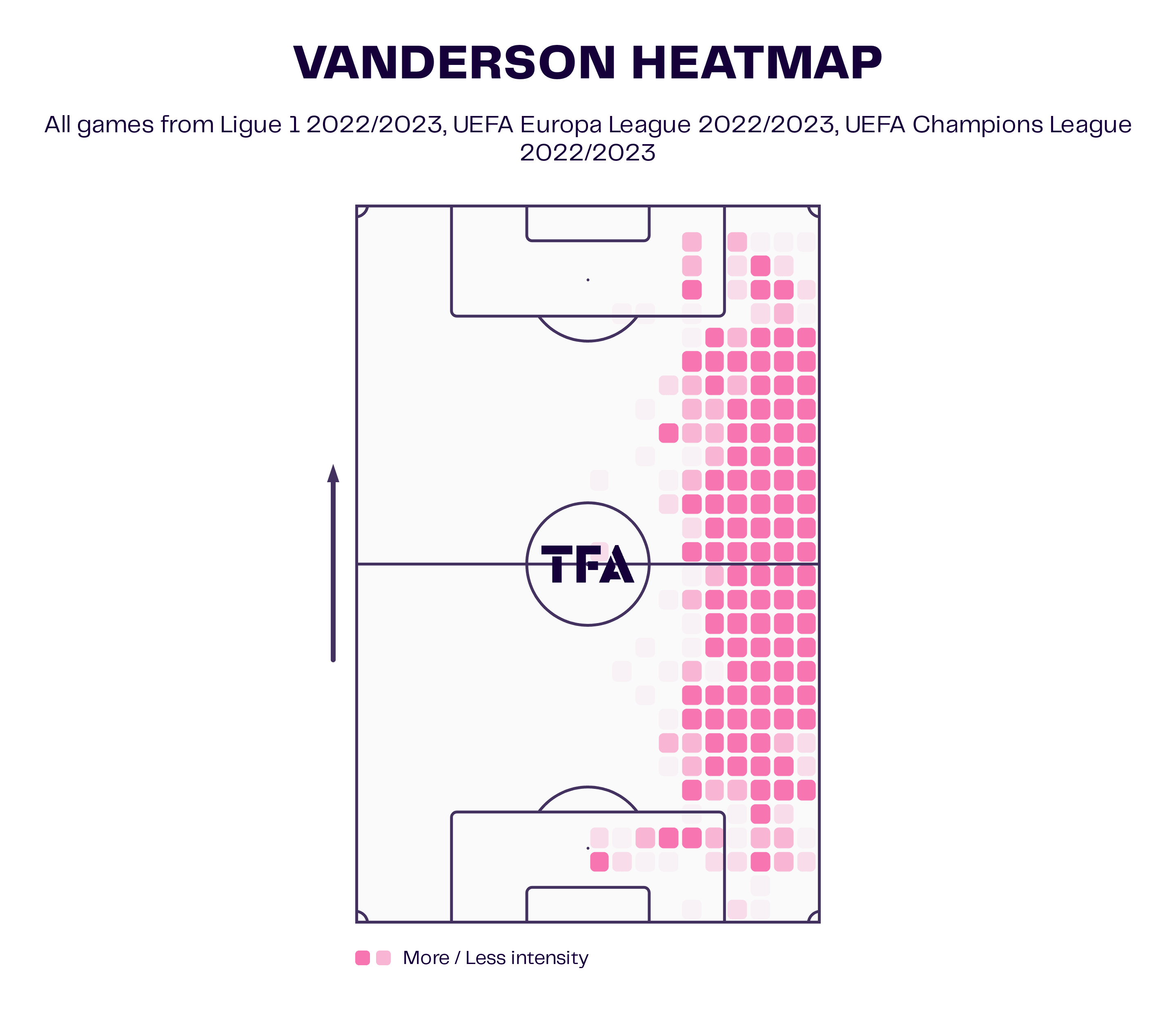
We can begin by looking at his 2022/23 heatmap above. Unlike traditional fullbacks, his movement tends to bleed well over into the right half-space. When he joined Monaco, Vanderson liked to burst forward and join the attack. A year later, his profile, especially in possession, has become much more well-rounded. His involvement in possession can be extremely dynamic, and he has no trouble inverting his positioning into the central areas.
In the last calendar year, he has averaged 46.62 passes per 90 (76.93%), with a healthy balance between lateral and forward passes. He also averages quite a few long passes, at 5.24 per 90 (52.27%). In a more detailed breakdown, we can see how often this involvement in possession tends to be in advanced areas. Vanderson has 6.52 passes to the final third per 90, and 3.66 passes to the penalty area per 90. His 1.28 through passes are especially impressive, as this is a high-quality method of creating chances.
We can see his pass map below to further illustrate his passing profile. A significant number of his successful passes are long switches to the opposite flank, and a lot of them are into the central areas. Overall, his pass map shows how resourceful and important he can be in possession.
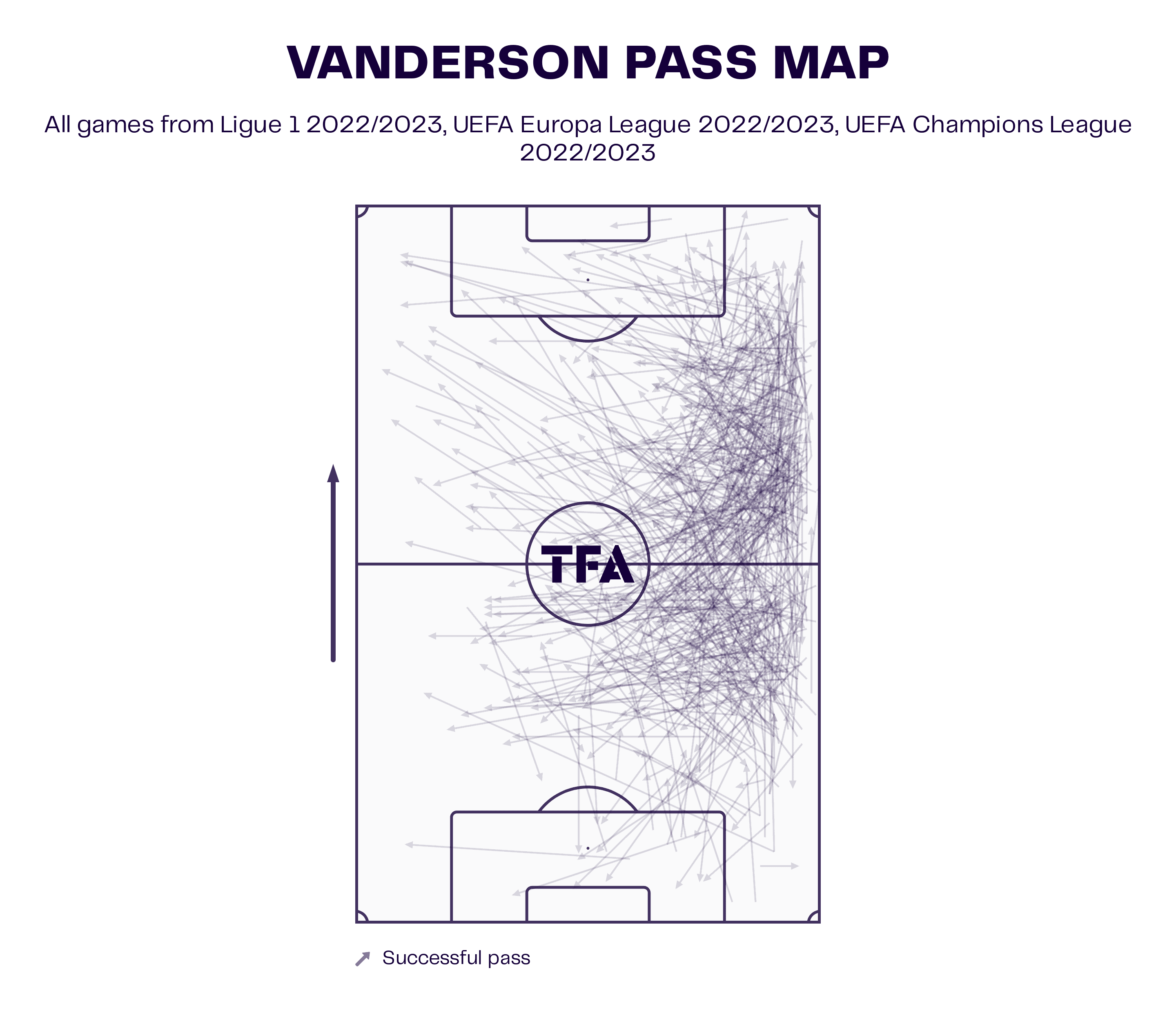
Through his penetrating carries, we are able to see another aspect of his game. Vanderson already has an incredible 79 penetrating carries this season, as illustrated by the map on the left side. On the right, we are able to see how often he likes to resort to dribbling and carrying the ball. He averages 3.9 dribbles per 90 at a 47.33% success rate, with an additional 1.88 progressive runs per 90. Finally, he is extremely good at helping Monaco progress through his passing as well, with 10.07 progressive passes per 90.
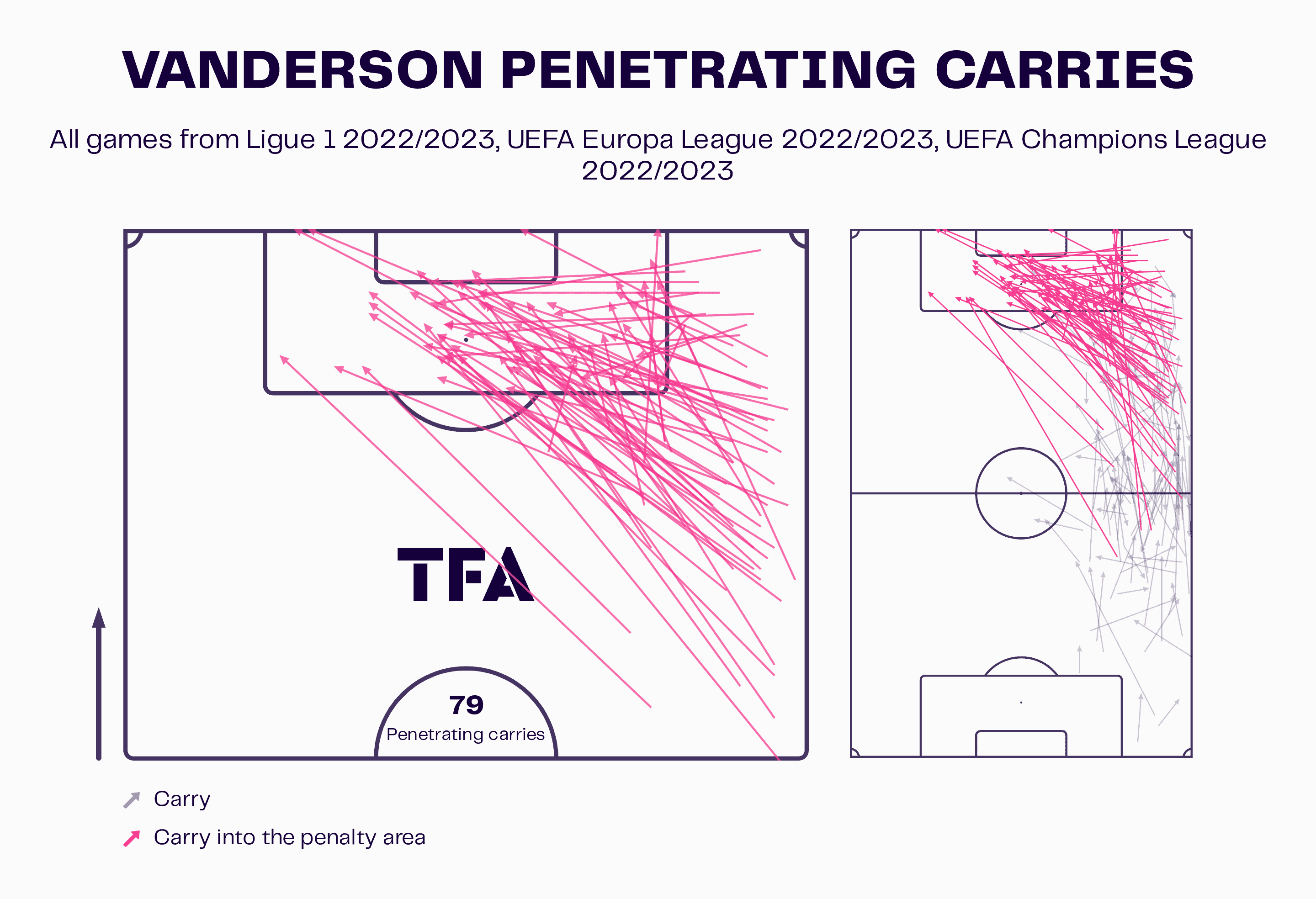
Out of possession, his defensive territory map provides a complete picture of where and how often he defends. His defensive behaviour follows a similar trend to his heatmap, both in positioning and actions. At any rate, we can take a deeper look at his defensive abilities through his statistics this calendar year.
Vanderson averages 10.4 successful defensive actions per 90 – the highest out of anyone on this list. Of his 8.28 defensive duels per 90, he wins an impressive 61.87% of them. His 2.65 aerial duels per 90 (42.7%) demonstrate another attribute of his. At 1,80m (5’11”), he is on the taller side of fullbacks. He is also able to read the game quite well with 5.09 interceptions per 90.
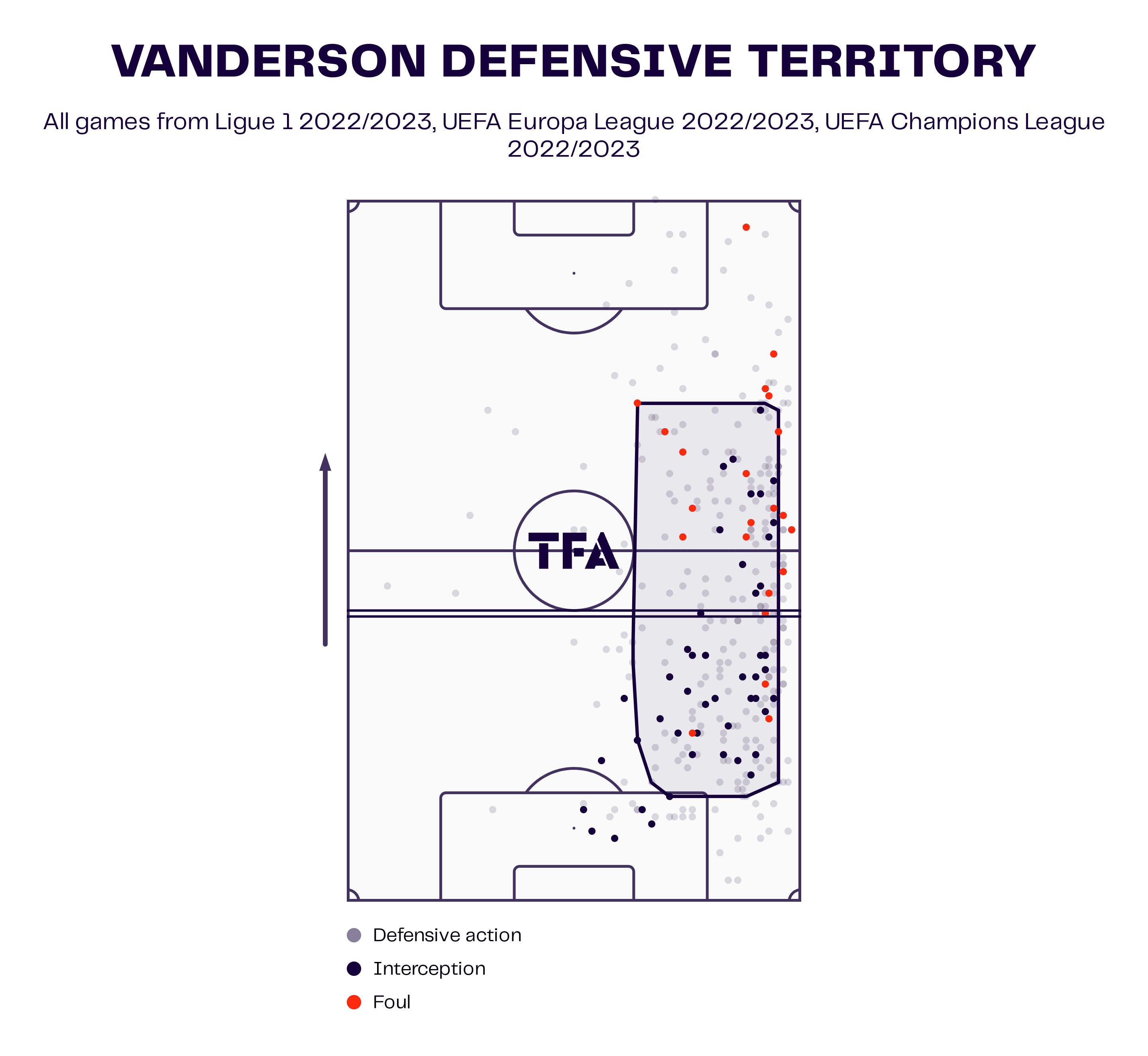
At just 21 years old, Vanderson is already an extremely well-rounded player. He is able to perform extremely well in all phases of the game, with a dynamic involvement in possession. He is most similar to Danilo, and as his career progresses, it would not be a surprise for his versatility to shine.
Yan Couto, 20 years old, Girona (on loan from Man City)
Next up is Yan Couto, a 20-year-old prospect at Girona. Yan Couto’s profile had already begun to grow before he even played for Coritiba’s senior team. In 2019, he was included in The Guardian’s “Next Generation 2019″ as one of the 60 best young talents in the world. His unique potential was spotted from an early age, and just one month after his professional debut, Manchester City signed him for €6M.
Since then, City have been constantly loaning him out. The first season was to Girona, the second to Braga, and now to Girona again in the third. Between Braga and Girona, Yan has made 82 professional appearances, with 12 goal contributions. At just 20 years old, he already has significant professional experience under his belt.
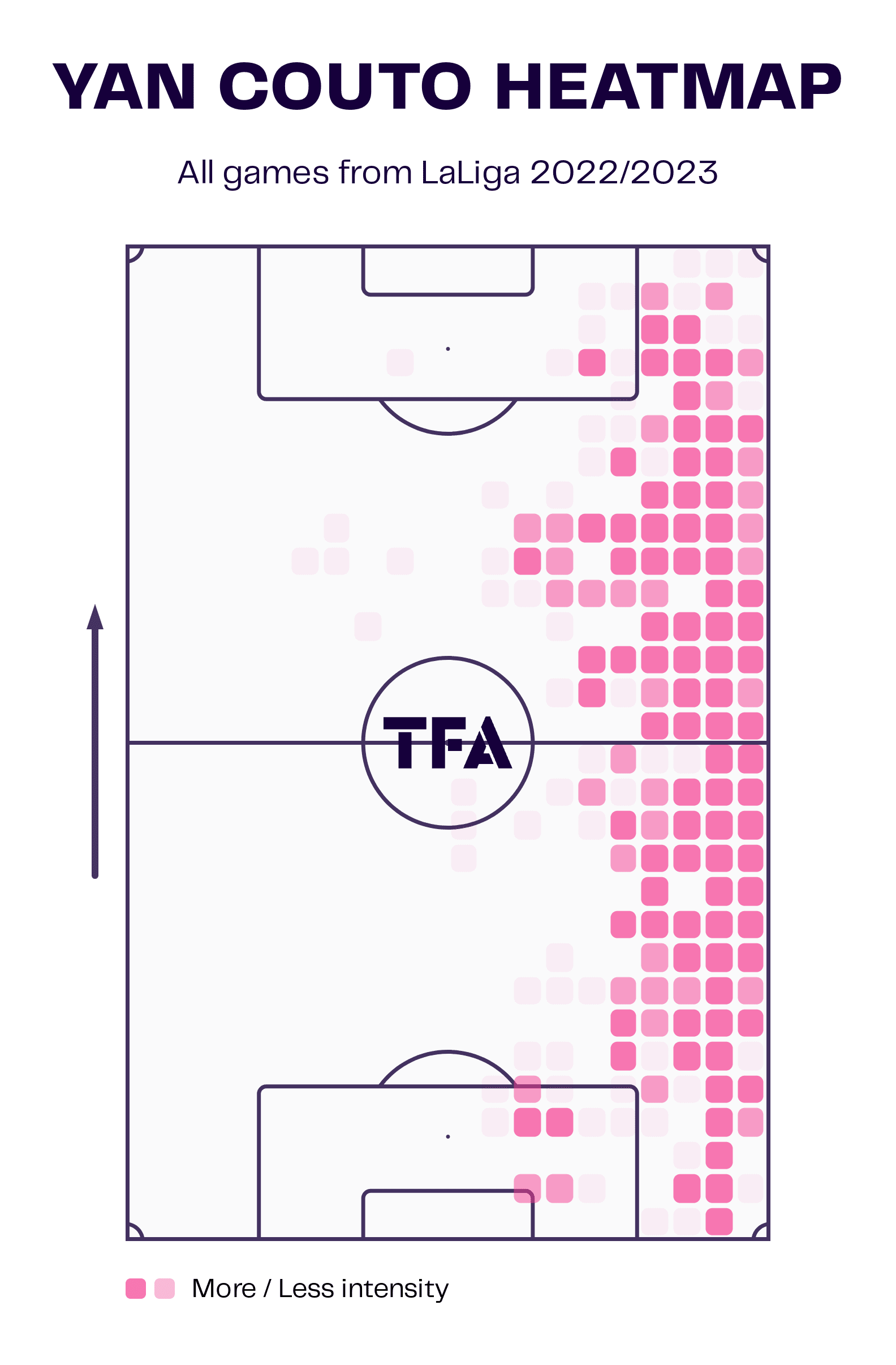
Yan Couto’s heatmap is more of a traditional fullback, remaining in the wide channel. His attacking involvement is quite impressive, constantly joining the attack in the opposition’s half. As you get closer to the final third, this activity becomes much more significant. This calendar year, he averages 5.9 passes to the final third and 4.96 to the penalty area – his presence in the attack is undeniable. His 9.18 progressive passes per 90 show he is capable of assisting in his team’s ball progression in earlier phases as well.
This passing contribution comes from his 50.29 passes per 90 (77.33%). This number is extremely impressive considering Girona average just over 51% of possession, and after all, he is a fullback. Again, there is a healthy balance between lateral and forward passes, and he is capable of going long as well with 4.02 long passes per 90 (53.4%). Yan has a rather similar profile to Vanderson, but his passing volume tends to be higher and less creative – a sign of a City Group team.
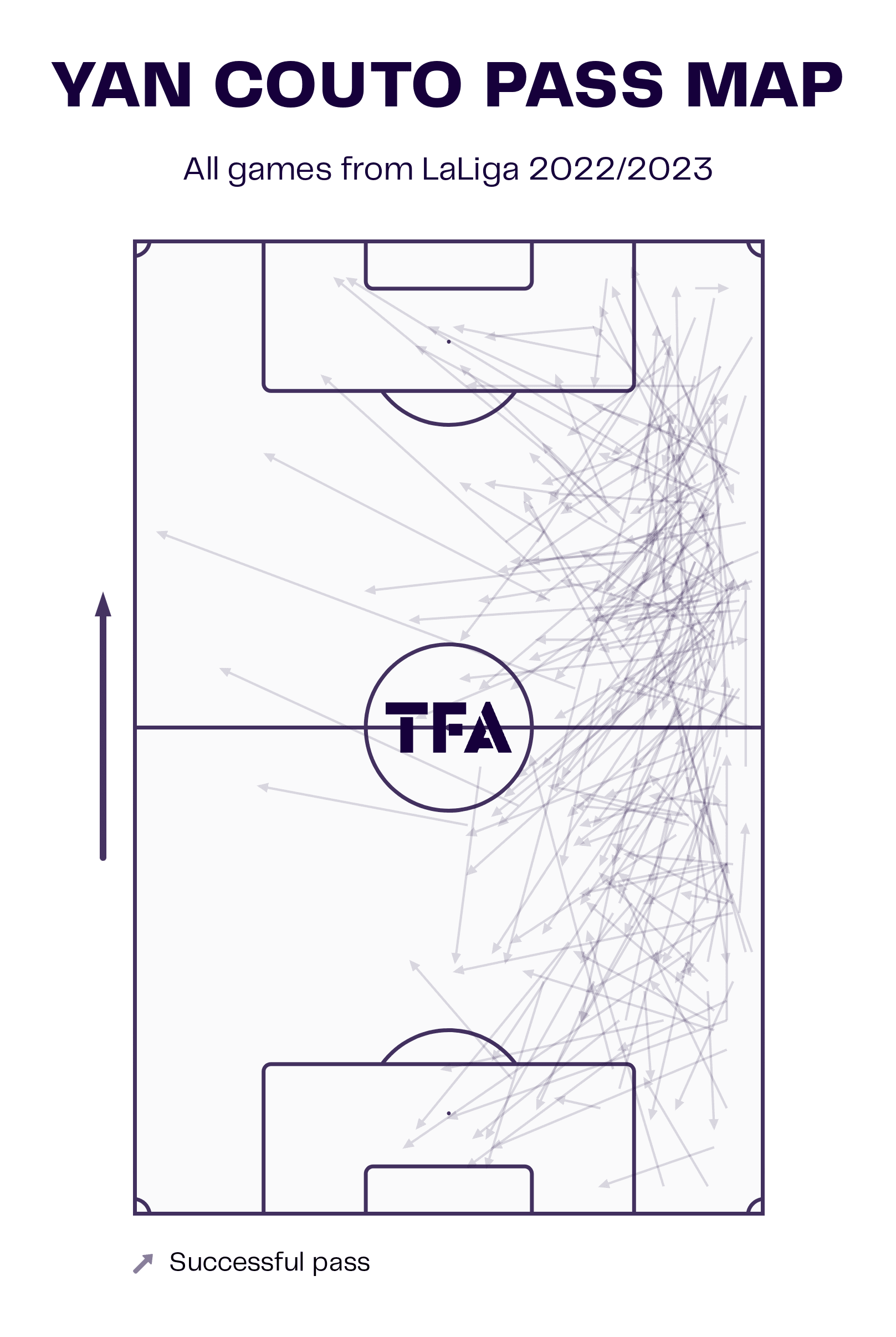
His dribbling ability also stands out, with 40 penetrating carries this season. While his dribbling involvement in the final third may not be as high as Vanderson’s, it certainly is in earlier phases. Yan averages 5.11 dribbles per 90 at a 54.2% success rate. Furthermore, he has 3.2 progressive runs per 90. The 20-year-old is an extremely resourceful player. He is able to get involved in possession through both his passing and dribbling, and he is excellent at progressing the ball.
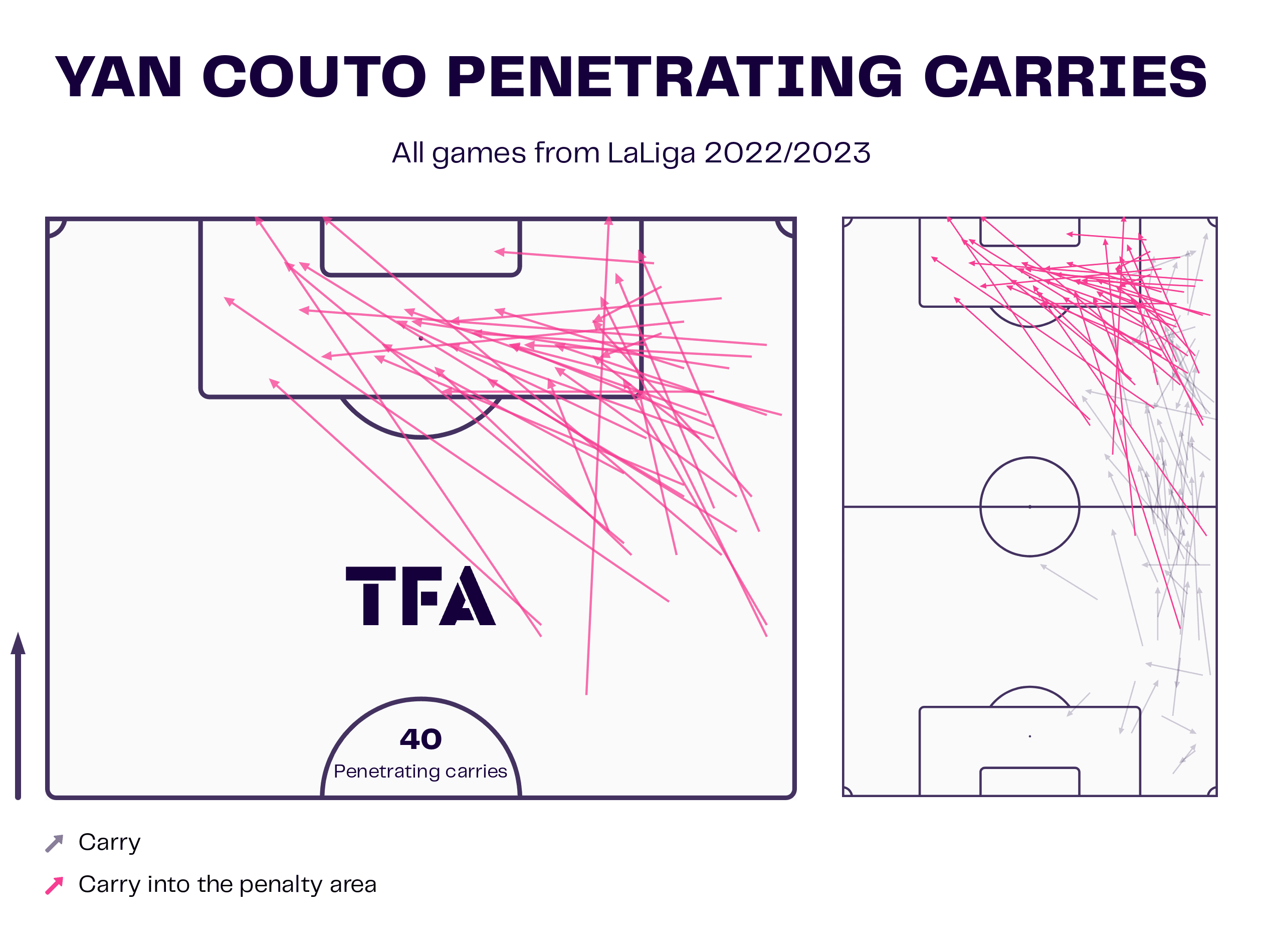
His defensive involvement is much lower. Couto only averages 7.5 successful defensive duels per 90, and of his 6.87 defensive duels per 90, he wins 58.52% of them. Additionally, he only has 3.28 interceptions per 90. Aerially, he is just 168cm (5’6”), so his 1.21 aerial duels per 90 at an extremely low 19.35% success rate are not a surprise. Defensively, he does not provide as much as he does on the ball. Although he can be effective in his actions, his volume is quite low. If there is one area of his game City must look to develop, it is his work out of possession.
Vinícius Tobías, 18 years old, Real Madrid (on loan from Shakhtar Donetsk)
Last up, we have a much younger prospect. Vinícius Tobías is just 18 years old, but his career has been rather eventful so far. His progress at Internacional’s youth academy was extremely exciting, and before even making his professional debut, Shakhtar Donetsk signed him for €6M. In fact, Vini has not made a single senior appearance at any of the clubs he has been at.
In the same month he joined Shakhtar, the war broke out and he was loaned out to Real Madrid Castilla. Although the loan is expiring soon, Madrid look set to buy the youngster for a reported fee of around €10M. Despite being just 18, his career has been extremely hectic. One thing is certain though – his potential.
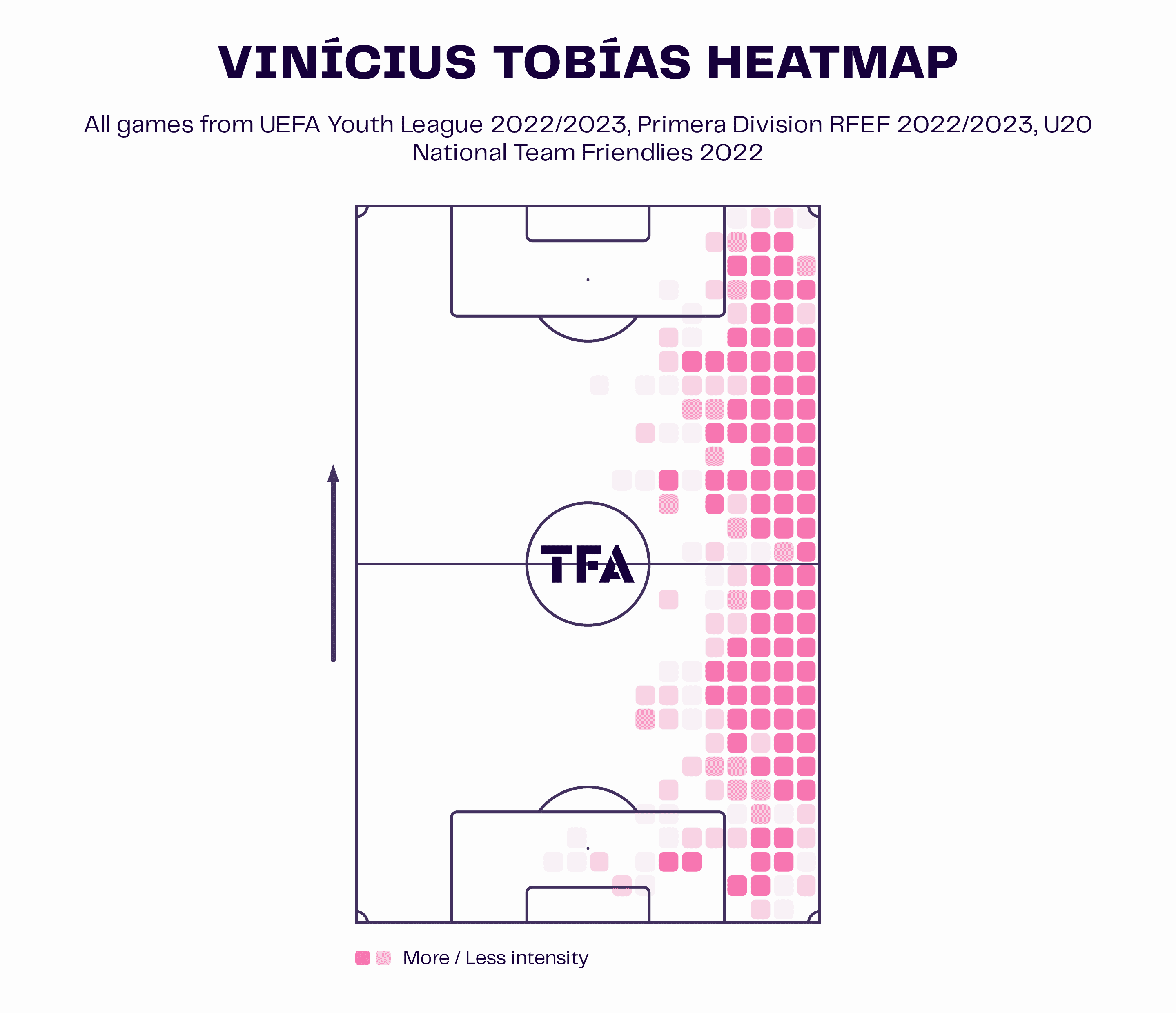
In addition to his performances at Real Madrid Castilla this year, he has also been a part of Brazil’s U20 squad. In these appearances, he has justified the hype around his career. Let’s begin with his heatmap. Above, we can see the 18-year-old is an extremely attacking fullback, with consistent activity all through the right wing.
Vinícius is a very technical player. Although his 2.71 dribbles per 90 are not the highest, they have an incredible 70.45% success rate. He also has 1.78 progressive runs per 90. In his ball progression map below, we are able to see how successful he is with his dribbling, as well as how often he is able to progress the ball with his dribbling.
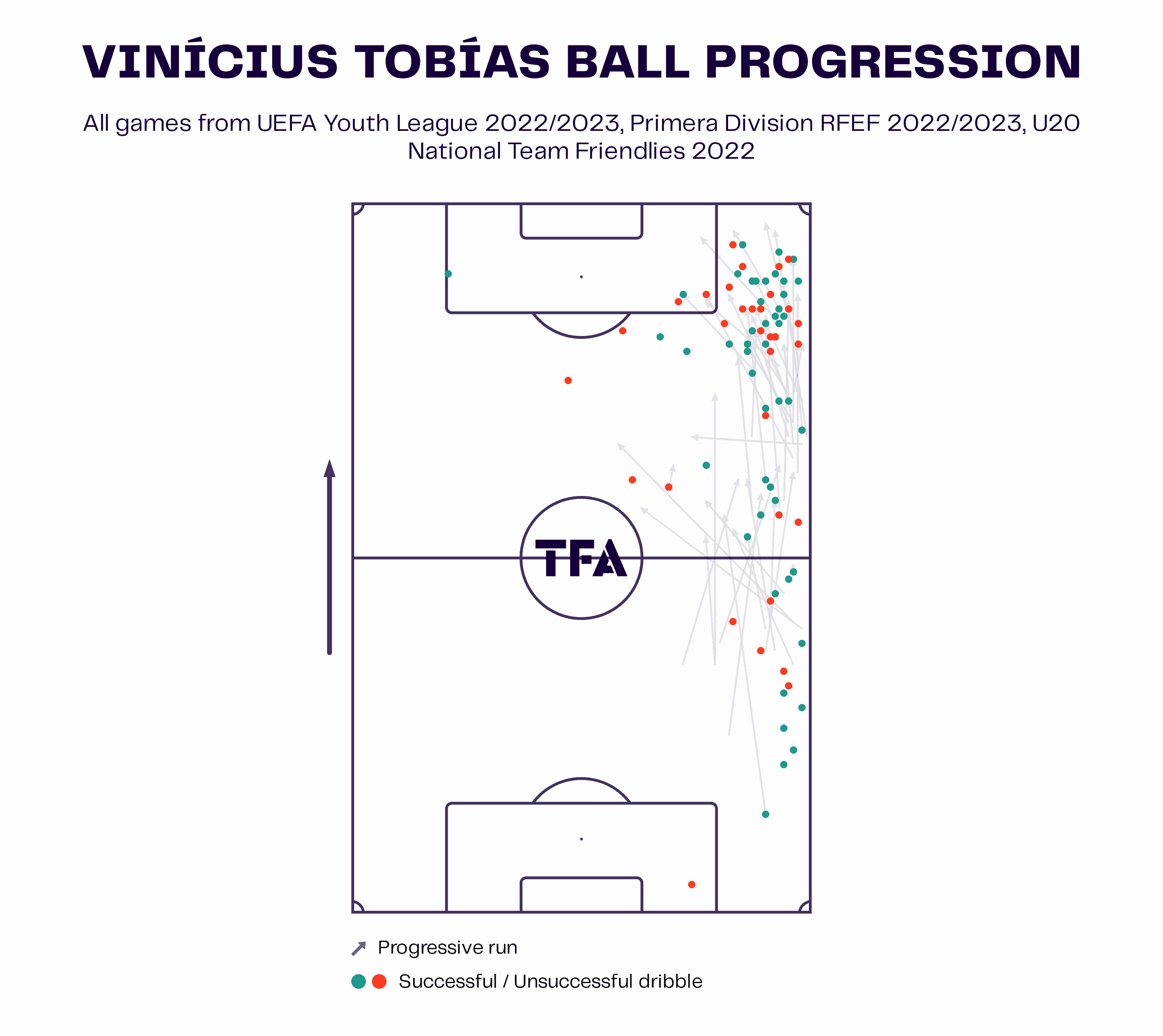
Vini is also able to get involved in possession through his passing. On the surface, he averages 39.49 passes per 90 at an 80.84% success rate. Unlike the previous two players, he has more lateral passes per 90 (16.06) than forward passes per 90 (10.64). In addition, he averages 4.24 long passes per 90. Finally, he is able to progress forward with his passes at 6.95 progressive passes per 90. Although his passing is not as impressive as his dribbling, it is still a resource he can rely on quite often.
As he gets further forward, this ability becomes more significant. He has 3.51 passes to the final third per 90 and 3.08 passes to the penalty area per 90. As seen below, he can also put his teammates in extremely dangerous situations, already creating up to 2.61 expected assists this season. While some of these are crosses, a lot come from deeper positions to put his teammates just inside the box.
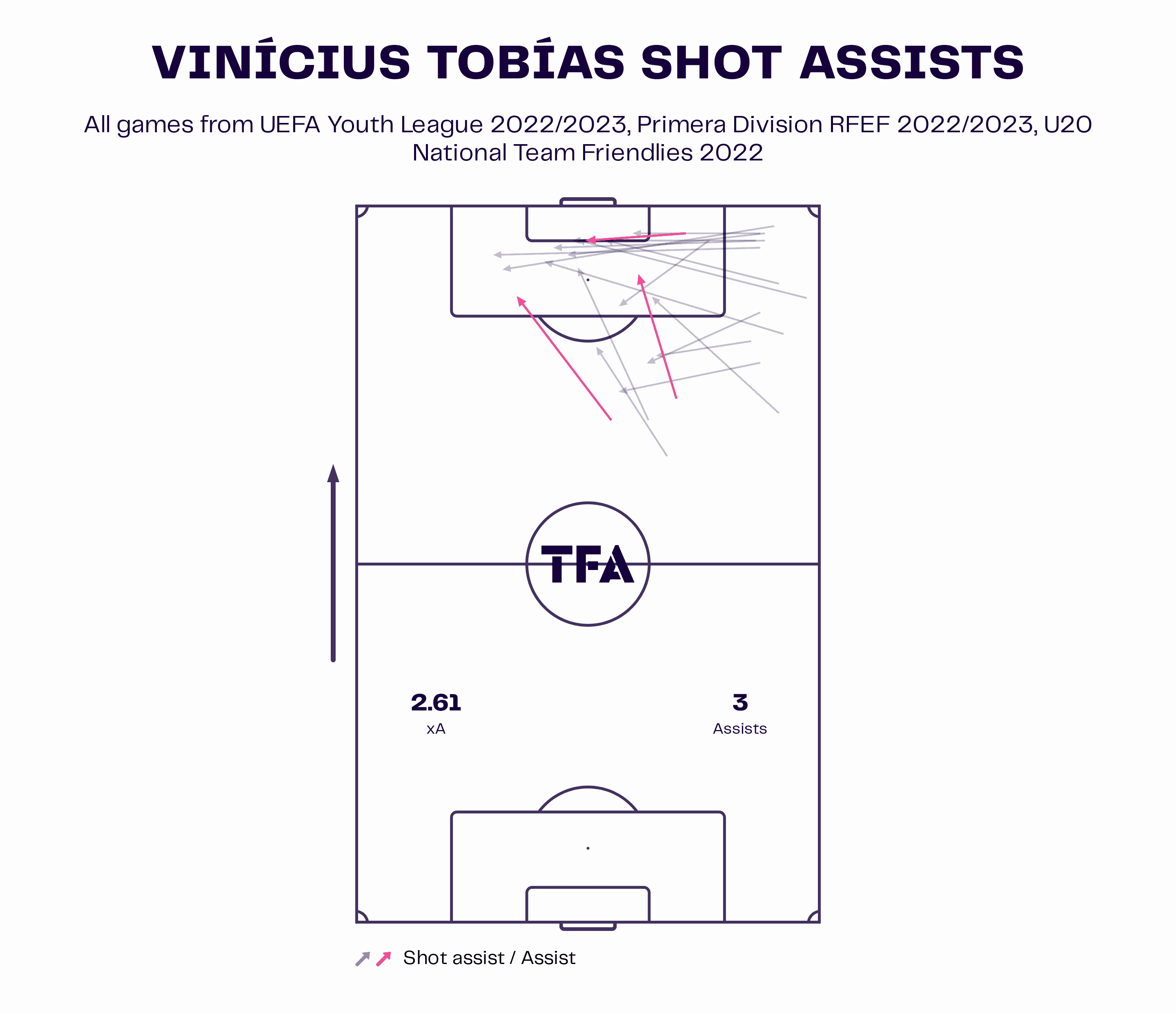
The 18-year-old also performs quite well defensively. This calendar year, he has performed 10.09 successful defensive duels per 90. He is quite active, at 8.8 defensive duels per 90, and wins a fair 53.15% of them. His 5.17 interceptions per 90 are also quite impressive, highlighting his ability to read and anticipate passes.
His defensive involvement in higher areas is especially impressive, as seen in his high regains map below. This season, he has 13 high regains and 27 counter-pressing recoveries, with nine of them leading to a shot in 20 seconds or less. Overall, his defensive ability is excellent, especially at just 18 years old.
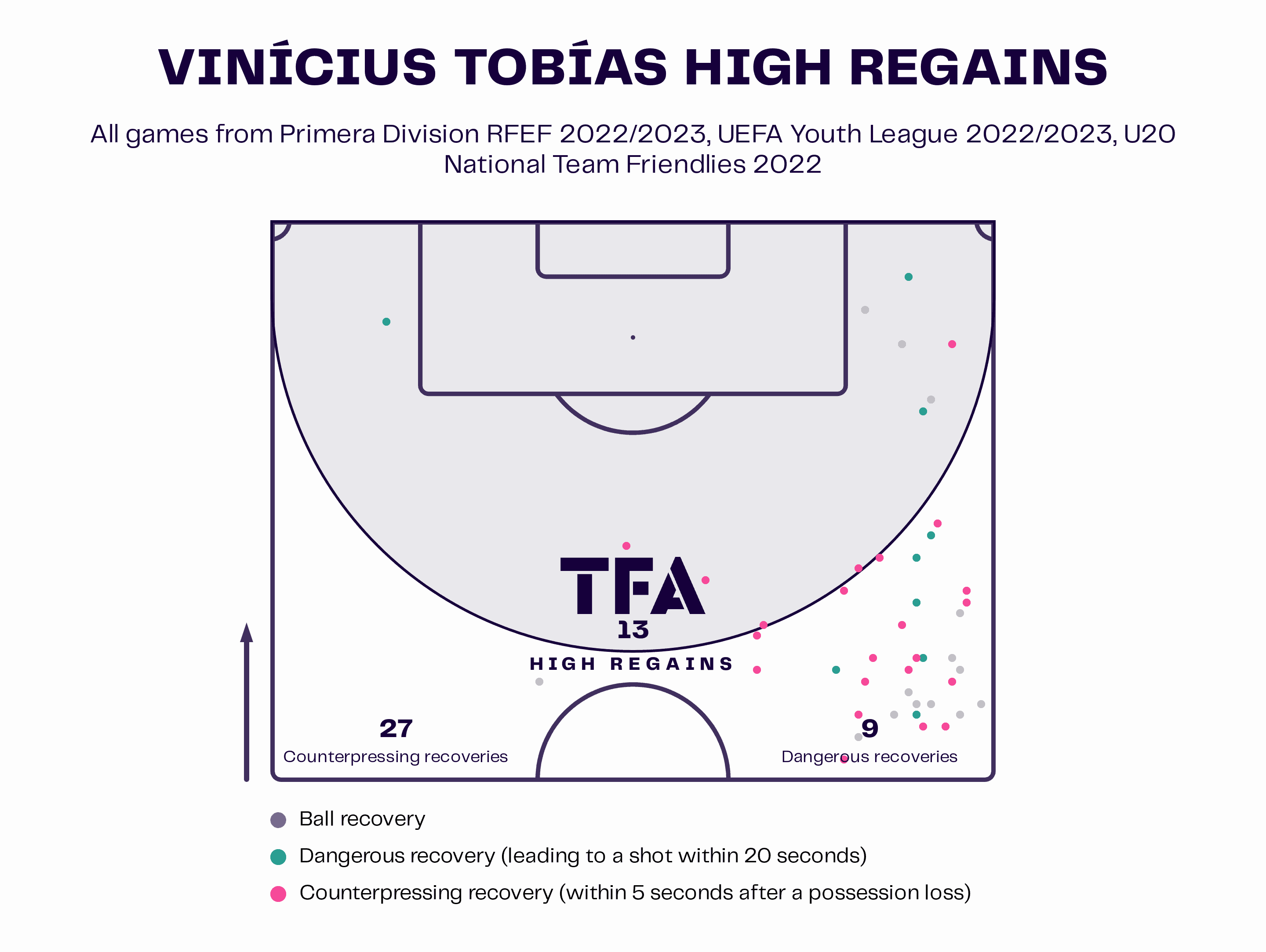
Conclusion
As the Seleção looks to the next 2026 World Cup cycle, these three young prospects can provide the answer to the country’s right-back dilemma. In fact, if they fulfil their potential, they can certainly become key players for the Brazilian national team. While Vinícius and Yan Couto are already in the biggest clubs of the world (Man City and Real Madrid), it will not be long before Vanderson joins them.
Nonetheless, these three players are still young and with a lot of development to go through. It will be very interesting to follow their career progression in the next few years, especially as the next Brazil manager will quickly start looking for options at the right-back position!

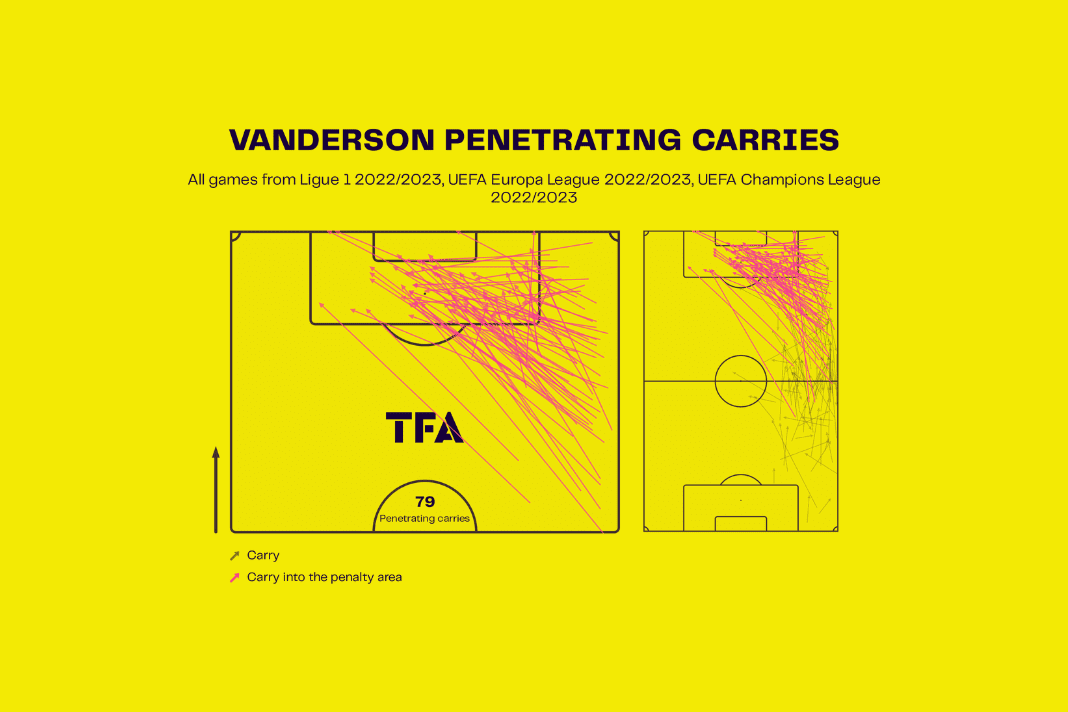



Comments